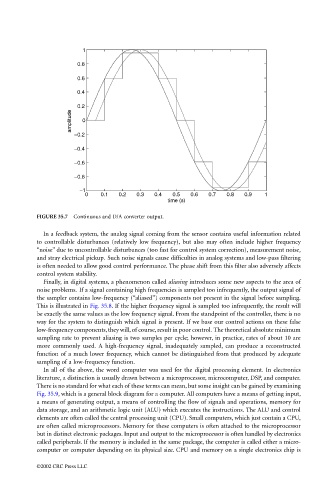Page 1029 - The Mechatronics Handbook
P. 1029
FIGURE 35.7 Continuous and D/A converter output.
In a feedback system, the analog signal coming from the sensor contains useful information related
to controllable disturbances (relatively low frequency), but also may often include higher frequency
“noise” due to uncontrollable disturbances (too fast for control system correction), measurement noise,
and stray electrical pickup. Such noise signals cause difficulties in analog systems and low-pass filtering
is often needed to allow good control performance. The phase shift from this filter also adversely affects
control system stability.
Finally, in digital systems, a phenomenon called aliasing introduces some new aspects to the area of
noise problems. If a signal containing high frequencies is sampled too infrequently, the output signal of
the sampler contains low-frequency (“aliased”) components not present in the signal before sampling.
This is illustrated in Fig. 35.8. If the higher frequency signal is sampled too infrequently, the result will
be exactly the same values as the low frequency signal. From the standpoint of the controller, there is no
way for the system to distinguish which signal is present. If we base our control actions on these false
low-frequency components, they will, of course, result in poor control. The theoretical absolute minimum
sampling rate to prevent aliasing is two samples per cycle; however, in practice, rates of about 10 are
more commonly used. A high-frequency signal, inadequately sampled, can produce a reconstructed
function of a much lower frequency, which cannot be distinguished from that produced by adequate
sampling of a low-frequency function.
In all of the above, the word computer was used for the digital processing element. In electronics
literature, a distinction is usually drawn between a microprocessor, microcomputer, DSP, and computer.
There is no standard for what each of these terms can mean, but some insight can be gained by examining
Fig. 35.9, which is a general block diagram for a computer. All computers have a means of getting input,
a means of generating output, a means of controlling the flow of signals and operations, memory for
data storage, and an arithmetic logic unit (ALU) which executes the instructions. The ALU and control
elements are often called the central processing unit (CPU). Small computers, which just contain a CPU,
are often called microprocessors. Memory for these computers is often attached to the microprocessor
but in distinct electronic packages. Input and output to the microprocessor is often handled by electronics
called peripherals. If the memory is included in the same package, the computer is called either a micro-
computer or computer depending on its physical size. CPU and memory on a single electronics chip is
©2002 CRC Press LLC

